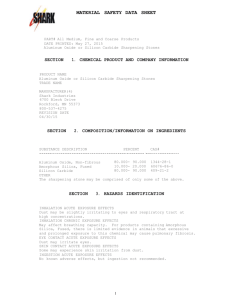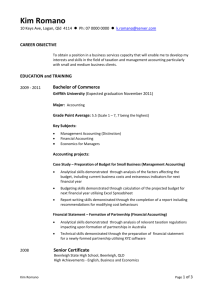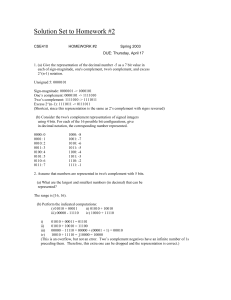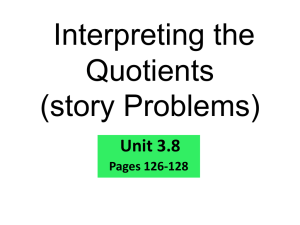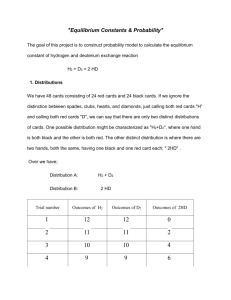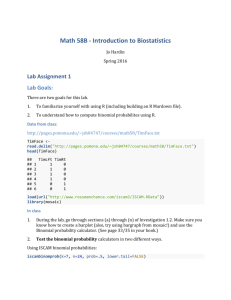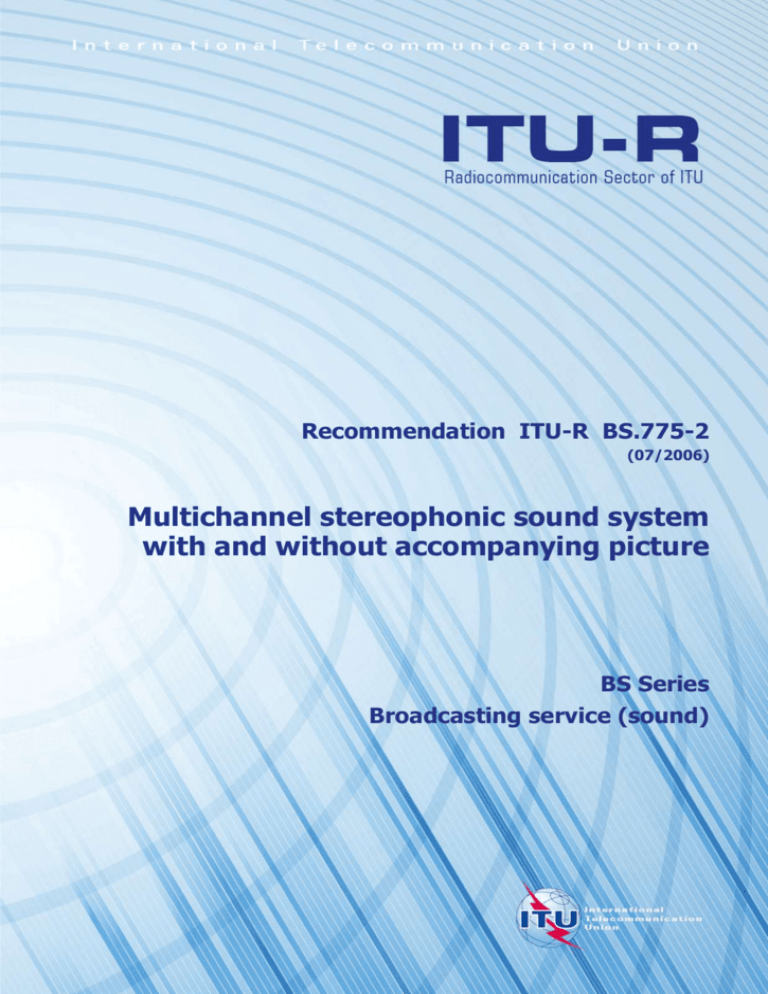
Recommendation ITU-R BS.775-2
(07/2006)
Multichannel stereophonic sound system
with and without accompanying picture
BS Series
Broadcasting service (sound)
ii
Rec. ITU-R BS.775-2
Foreword
The role of the Radiocommunication Sector is to ensure the rational, equitable, efficient and economical use of the
radio-frequency spectrum by all radiocommunication services, including satellite services, and carry out studies without
limit of frequency range on the basis of which Recommendations are adopted.
The regulatory and policy functions of the Radiocommunication Sector are performed by World and Regional
Radiocommunication Conferences and Radiocommunication Assemblies supported by Study Groups.
Policy on Intellectual Property Right (IPR)
ITU-R policy on IPR is described in the Common Patent Policy for ITU-T/ITU-R/ISO/IEC referenced in Annex 1 of
Resolution ITU-R 1. Forms to be used for the submission of patent statements and licensing declarations by patent
holders are available from http://www.itu.int/ITU-R/go/patents/en where the Guidelines for Implementation of the
Common Patent Policy for ITU-T/ITU-R/ISO/IEC and the ITU-R patent information database can also be found.
Series of ITU-R Recommendations
(Also available online at http://www.itu.int/publ/R-REC/en)
Series
BO
BR
BS
BT
F
M
P
RA
RS
S
SA
SF
SM
SNG
TF
V
Title
Satellite delivery
Recording for production, archival and play-out; film for television
Broadcasting service (sound)
Broadcasting service (television)
Fixed service
Mobile, radiodetermination, amateur and related satellite services
Radiowave propagation
Radio astronomy
Remote sensing systems
Fixed-satellite service
Space applications and meteorology
Frequency sharing and coordination between fixed-satellite and fixed service systems
Spectrum management
Satellite news gathering
Time signals and frequency standards emissions
Vocabulary and related subjects
Note: This ITU-R Recommendation was approved in English under the procedure detailed in Resolution ITU-R 1.
Electronic Publication
Geneva, 2010
ITU 2010
All rights reserved. No part of this publication may be reproduced, by any means whatsoever, without written permission of ITU.
Rec. ITU-R BS.775-2
1
RECOMMENDATION ITU-R BS.775-2*,**,***
Multichannel stereophonic sound system with
and without accompanying picture
(1992-1994-2006)
Scope
Digital TV is rapidly gaining ground around the world. Several digital television broadcasting services have
already been introduced in the terrestrial and in the satellite bands. As part of these digital broadcasting
services, multichannel audio services are used or have been specified to enhance the directional stability of
the frontal sound image and the sensation of spatial reality (ambience).
Recommendation ITU-R BS.775 recommends one universal multichannel stereophonic sound system with
three front channels and two rear/side channels together with an optional low frequency effects (LFE)
channel.
The ITU Radiocommunication Assembly,
considering
a)
that it is widely recognized that a two-channel sound system has serious limitations and
improved presentation is necessary;
b)
that the requirements of cinema presentation differ from those that apply in the home,
particularly with respect to room and screen size and distribution of listeners, but that the same
programmes may be reproduced in either the cinema or the home;
c)
that broadcast HDTV signals, and those delivered by other media, should be capable of
giving appropriate sound quality with a wide range of domestic loudspeaker configurations,
including compatibility with two-channel stereophonic and monophonic listening;
d)
that for multichannel sound it is desirable to separate the requirements of production,
delivery and domestic presentation, though these are mutually interacting;
e)
that investigations about multichannel sound transmission and reproduction associated and
not associated with accompanying picture are being carried out with the basic requirements;
f)
that one universal multichannel sound system applicable to both sound and television
broadcasting would be beneficial to the listener;
g)
that compromises may be necessary to ensure that the system is as universal and as
practical as possible;
h)
that a hierarchy of compatible sound systems for broadcasting, cinema and recordings is
useful for programme exchange and up- and down-mixing depending on the programme material;
*
This Recommendation should be brought to the attention of the International Electrotechnical
Commission (IEC) and the Society of Motion Picture and Television Engineers (SMPTE).
**
Radiocommunication Study Group 6 made editorial amendments to this Recommendation in 2002 in
accordance with Resolution ITU-R 44.
***
Radiocommunication Study Group 6 made editorial amendments to this Recommendation in
November 2009 in accordance with Resolution ITU-R 1.
2
Rec. ITU-R BS.775-2
j)
that ancillary services such as those for the visually impaired and hearing impaired are
desirable;
k)
that advances in digital audio coding currently allow the delivery of multiple audio
channels in an efficient manner,
recommends
1
one universal multichannel stereophonic sound system, with or without accompanying
picture, within a hierarchy given in Annex 1;
2
–
the following reference loudspeaker arrangement (see Fig. 1):
three front loudspeakers combined with two rear/side loudspeakers (Note 1);
–
the left and right frontal loudspeakers are placed at the extremities of an arc subtending 60
at the reference listening point (Notes 2 and 3).
Where for reasons of available space, it is preferred to place the frontal loudspeakers on a
straight line base, then it may be necessary to introduce compensating time delays in the
signal feed of the centre loudspeaker;
–
both side/rear loudspeakers should be placed within the sectors from 100 to 120 from the
centre front reference. Precise location is not necessary. Side/rear loudspeakers should be
no closer to the listener than the frontal loudspeakers, unless compensating time delay is
introduced (Notes 4 and 5);
the acoustic centre of frontal loudspeakers should ideally be at a height approximately equal
to that of the listener’s ears. This implies an acoustically transparent screen. Where a nonacoustically transparent screen is used, the centre loudspeaker should be placed
immediately above or below the picture. The height of side/rear loudspeakers is less
critical;
–
3
the use of five reference recording/transmission signals for left (L), right (R), centre (C),
channels for the front, and left surround (LS) and right surround (RS) channels for the side/rear.
Additionally the system may include a low frequency effects signal for a low frequency effects
(LFE) channel (see Annex 7).
In circumstances where transmission capacity or other constraints apply, the LS and RS signals can
be combined with one (mono surround, MS) or zero rear/side signals. In the case of mono surround,
the MS signal is fed to both LS and RS loudspeakers (see Fig. 1);
4
compatibility, if required, with existing and low cost receivers by using one of the methods
given in Annex 3;
5
down-mixing capability, if required, for reduction of the number of channels, either prior to
transmission or at the receiver, by employing the down-mixing equations given in Table 2;
6
upward conversion where an increase in the number of channels is desired, either prior to
transmission or at the receiver, by employing upwards-conversion techniques described in Annex 5;
7
overall quality to the requirements of Annex 2;
8
–
–
provision (but see also § 9 below) for the following if necessary:
alternate multiple language principal services;
one or more independent channels carrying descriptive information for the visually
impaired;
one or more independent channels for the purpose of supplying improved intelligibility to
the hearing impaired;
–
Rec. ITU-R BS.775-2
3
9
additional data transmitted with the audio to enable the flexible use of the data capacity
allocatable to audio signals (see Annex 6).
NOTE 1 – Optionally, there may be an even number of more than two rear/side loudspeakers which
may provide a larger optimum listening area and greater envelopment.
NOTE 2 – Optimum sound reproduction requires use of wide angular spacing between the left and
right loudspeakers of two or three front loudspeaker channel stereophonic systems (see Fig. 1). It is
recognized that the television pictures accompanying stereophonic sound having such an angular
4
Rec. ITU-R BS.775-2
width cannot, with current techniques, be displayed to the same wide angles, but are often restricted
to 33 horizontal subtended angle at the reference distance, although cinema images may be
displayed at such angles (see Fig. 1). The resulting mismatch between picture and sound image
width leads to differences in mixing technique for cinema and television. It is expected that larger
television displays will lead to better compatibility of mixes for cinema and television display.
NOTE 3 – The size of the loudspeaker basewidth, B (see Fig. 1), is defined for reference listening
test conditions in Recommendation ITU-R BS.1116 – Methods for the subjective assessment of
small impairments in audio systems including multichannel sound systems.
NOTE 4 – If more than two rear/side loudspeakers are used, then the loudspeakers should be
disposed symmetrically and at equal intervals on the arc which measures from 60 to 150 from the
centre front reference (see Fig. 2).
NOTE 5 – If more than two rear/side loudspeakers are used, the LS signal should be fed to each of
the side/rear loudspeakers on the left side of the room and the RS signal should be fed to each of the
side/rear loudspeakers on the right side of the room. In doing so, it will be necessary to reduce the
signal gain such that the total power emitted by the loudspeakers carrying the LS (or RS) signal is
the same as if that signal had been reproduced over a single loudspeaker. For large room
reproduction, it may also be necessary to delay, or otherwise de-correlate, the feeds to some or all of
the side/rear loudspeakers. Further studies on such de-correlation is necessary.
Rec. ITU-R BS.775-2
Annex 1
Hierarchy of compatible multichannel sound systems
for broadcasting and recording
5
6
Rec. ITU-R BS.775-2
Annex 2
Basic requirements
The following requirements are related to the specified multichannel sound system with and without
accompanying picture.
1
The directional stability of the frontal sound image shall be maintained within reasonable
limits over a listening area larger than that provided by conventional two-channel stereophony.
2
The sensation of spatial reality (ambience) shall be significantly enhanced over that
provided by conventional two-channel stereophony. This shall be achieved by the use of side and/or
rear loudspeakers.
3
It is not required that the side/rear loudspeakers should be capable of the prescribed image
locations outside the range of the front loudspeakers.
4
Downward compatibility with sound systems providing lower number of channels (down to
stereophonic and monophonic sound systems) shall be maintained (see Annexes 1, 3, 4 and 8).
5
Real-time mixing for live broadcast shall be practicable.
6
In cases where the number of delivered signals is smaller than the number of reproduction
channels upward conversion should be ensured to an acceptable degree (see Annex 5).
7
The basic audio quality of the sound reproduced after decoding shall be subjectively
indistinguishable from the reference for most types of audio programme material. Using the triple
stimuli with hidden reference test implies grades consistently higher than four on the ITU-R
impairment 5-grade scale. The most critical material shall not be graded lower than four. For
subjective assessments and listening test conditions see Recommendation ITU-R BS.1116.
8
For the objective quality parameters Recommendations ITU-R BS.644 and ITU-R BS.645
shall be the basis for digital techniques. For objective measurements method of perceived audio
quality for mono or two-channel stereo sound see Recommendation ITU-R BS.1387. (The objective
measurements method for multichannel stereophonic sound is under study by ITU-R.)
9
Relative timing of the synchronization of sound and vision signals see Recommendation
ITU-R BT.1359.
10
Optimum economy shall be pursued in all respects, including both cost and transmission
bandwidth.
11
For user requirements for audio coding systems for digital broadcasting see
Recommendation ITU-R BS.1548.
Rec. ITU-R BS.775-2
7
Annex 3
Compatibility
1
Backward compatibility with existing receivers
In the case that an existing 2/0 channel format is extended to a 3/2 channel format, two methods
have been identified to assure backward compatibility with existing receivers.
One method is to continue providing the existing 2/0 channel service and to add the new
3/2 channel service. This approach is referred to as a simulcasting operation. The advantage of this
approach is that the existing 2/0 service could be discontinued at some point in the future.
Another method is the use of compatibility matrices. The matrix equations shown in Table 1 may be
used to provide compatibility with existing receivers. In this case, the existing Left and Right
emission channels are used to convey the compatible A and B matrix signals. Additional emission
channels are used to convey the T, Q1, and Q2 matrix signals. The advantage of this approach is that
less additional data capacity is required to add the new service.
TABLE 1
Five channel surround: encoding and decoding equations
Encoding equations
A
B
T
Q1
Q2
L
R
C
LS
RS
2
A
1.0000
0.0000
0.0000
0.0000
0.0000
B
0.0000
1.0000
0.0000
0.0000
0.0000
L
1.0000
0.0000
0.0000
0.0000
0.0000
T
–1.0000
–1.0000
01.4142
00.0000
00.0000
R
C
0.0000
0.7071
1.0000
0.7071
0.0000
0.7071
0.0000
0.0000
0.0000
0.0000
Decoding equations
Q1
–0.5000
–0.5000
00.0000
00.7071
00.7071
Q2
–0.5000
00.5000
00.0000
00.7071
–0.7071
LS
0.7071
0.0000
0.0000
0.7071
0.7071
L
1.0000
0.0000
0.0000
0.0000
0.0000
RS
–0.0000
–0.7071
–0.0000
–0.7071
–0.7071
R
0.0000
1.0000
0.0000
0.0000
0.0000
C
0.0000
0.0000
1.0000
0.0000
0.0000
LS
0.0000
0.0000
0.0000
1.0000
0.0000
RS
0.0000
0.0000
0.0000
0.0000
1.0000
Downward compatibility with low-cost receivers
Two methods have been identified which provide downward compatibility with low receiver
complexity. The first requires the use of the matrix process described in § 1. A low-cost receiver
then only requires the A- and B-channels as in the case of the 2/0 system, i.e. a system which does
not use a backwards compatibility matrix.
The second method is applicable to the discrete 3/2 delivery system. The delivered signals are
digitally combined using the equations in Annex 4, which enable the required number of signals to
be provided. In the case of low bit-rate source coded signals, the downward mixing of the
3/2 signals may be performed prior to the synthesis portion of the decoding process (where the bulk
of the complexity lies).
8
Rec. ITU-R BS.775-2
Annex 4
Downward mixing of multichannel audio signals
1
3/2 source signals
Table 2 shows a set of equations that may be used to mix the five signals of the 3/2 system down to
the formats: 1/0; 2/0; 3/0; 2/1; 3/1; 2/2.
TABLE 2
Downward mixing equations for 3/2 source material
Mono – 1/0 format
L
R
C
LS
RS
0.7071
0.7071
1.0000
0.5000
0.5000
L
R
C
LS
RS
1.0000
0.0000
0.7071
0.7071
0.0000
R
0.0000
1.0000
0.7071
0.0000
0.7071
L
R
C
LS
RS
L
1.0000
0.0000
0.0000
0.7071
0.0000
R
0.0000
1.0000
0.0000
0.0000
0.7071
C
0.0000
0.0000
1.0000
0.0000
0.0000
L
R
C
LS
RS
1.0000
0.0000
0.7071
0.0000
0.0000
R
0.0000
1.0000
0.7071
0.0000
0.0000
S
0.0000
0.0000
0.0000
0.7071
0.7071
L
R
C
LS
RS
C
Stereo – 2/0 format
L
Three channels – 3/0 format
Three channels – 2/1 format
L
Four channels – 3/1 format
1.0000
0.0000
0.0000
0.0000
0.0000
R
0.0000
1.0000
0.0000
0.0000
0.0000
C
0.0000
0.0000
1.0000
0.0000
0.0000
S
0.0000
0.0000
0.0000
0.7071
0.7071
L
R
C
LS
RS
1.0000
0.0000
0.7071
0.0000
0.0000
R
0.0000
1.0000
0.7071
0.0000
0.0000
LS
0.0000
0.0000
0.0000
1.0000
0.0000
RS
0.0000
0.0000
0.0000
0.0000
1.0000
L
Four channels – 2/2 format
L
It should be noted that the overall effect of such downward mixing equations (and compatibility
matrixing, see Annex 3) will depend on other factors, such as the panning equations and
microphone characteristics. It is recommended that further studies on such interactions be carried
out (see Annex 8).
Rec. ITU-R BS.775-2
9
Annex 5
Upwards conversion
Upwards conversion is needed in cases where the number of production channels is smaller than the
number of channels available for reproduction. A typical example is a 2-channel stereo programme
(2/0) that is to be presented over a 3/2 reproduction system.
Upwards conversion involves the generation of the “missing” channels somewhere in the broadcast
chain. When performing upwards conversion, the following guidelines should normally be
respected in order that the programme makers have a reference arrangement. These guidelines do
not exclude the possibility, for receiver manufacturers, of the implementation of more sophisticated
techniques.
1
Frontal channels
1.1
When a monophonic programme is to be presented over a reproduction system with three
frontal loudspeakers, the mono signal should be presented over the centre loudspeaker only. When
two frontal loudspeakers are only available, the mono signal should be presented over both left and
right loudspeakers with an attenuation of 3 dB.
1.2
When a stereophonic programme is to be presented over a reproduction system with three
frontal loudspeakers, the left and right signals of the stereo programme should be presented
respectively over the left and right loudspeakers only.
2
Surround channels
2.1
When there is no surround signal in a programme, surround loudspeakers should not be
activated.
2.2
When a given surround signal is to be reproduced over more than one loudspeaker,
de-correlation between each loudspeaker signal should be performed. Furthermore, proper
attenuation should be applied to each loudspeaker signal so that the combined sound pressure level
produced by these loudspeakers should match that of a single frontal loudspeaker if fed by the same
signal at a given reference listening position.
3
Data channel
Auxiliary information describing the mode of transmission (number and type of transmitted
channels) should be transmitted periodically in a special data channel in parallel with the
programme. This information will be needed to perform upwards conversion in receivers.
10
Rec. ITU-R BS.775-2
Annex 6
Additional data*
It is necessary that some additional data are sent to the multichannel sound receiver, to enable it to
identify the multichannel sound configuration in use, and provide the loudspeakers with the
required signals. Implicit in the ability to reconfigure a multichannel sound system is the ability to
use the available sound channels flexibly, so that a wide range of applications can be covered.
The details of the additional data (bit rate, data format, etc.) have yet to be determined. However,
the following applications, which would need to be signalled in the data channel, have been
identified:
–
the signalling and controlling of different multichannel sound configurations for the main
programme and conversion (e.g. 5-channel, 3-channel, 2-channel, mono) to other
configurations;
–
indicating a special sound signal for listeners with impaired hearing;
–
indicating a special sound signal for viewers with impaired sight;
–
indicating a separate audio programme (SAP);
–
conveying dynamic range control information, to compress or expand the dynamic range;
–
conveying characters for a text service;
–
flexible usage of the data capacity allocated for audio signals.
Annex 7
Low frequency effects channel (LFE)
The purpose of this optional channel is to enable listeners, who choose to, to extend the low
frequency content of the reproduced programme in terms of both frequency and level. It was
originally devised by the film industry for their digital sound systems.
In the film industry the LFE channel carries high level, low frequency sound effects which are
intended to be fed to specific low frequency loudspeakers (subwoofers). In that way the magnitude
of the low frequency content of the other channels is restricted so that the main loudspeakers are not
required to handle these special effects signals. The main film sound channels carry normal low
frequency sounds but not at such high levels. They are therefore sufficient on their own if these
special effects are not required by the user. This combination has the other benefit that the coding of
the high level signals in the LFE channel can be optimized without affecting the coding of the main
channels.
Although it is recognized that the number of domestic consumers who will choose to use a LFE
channel is likely to be restricted, it is also recognized that there are other applications of the HDTV
sound system that make more use of this option.
*
Further studies and contributions from administrations are necessary.
Rec. ITU-R BS.775-2
11
The LFE channel should not, however, be used for the entire low frequency content of the
multichannel sound presentation. The LFE channel is an option, at the receiver, and thus should
only carry the additional enhancement information.
(In a similar way, the surround channels should carry their own low frequency information rather
than it being mixed into the front channels. This forward mixing of the low frequency sounds is an
option, at the receiver, to decrease the requirements on the surround loudspeakers.)
The LFE channel should be capable of handling signals in the range 20-120 Hz.
Recommendation ITU-R BR.1384 specifies that the LFE channel is recorded with a level offset of –
10 dB for the recording and exchange of multichannel sound programme material, and this offset is
compensated for in the reproduction system. For broadcasting applications where signal levels are
compliant with Recommendation ITU-R BR.1384, the level of LFE channel should be reproduced
with positive offset gain of 10 dB relative to the main channels on reproduction.
NOTE 1 – The film industry encodes the LFE channel such that a positive gain of 10 dB is required on
reproduction and the reproduction level for DVD-Video is set to a positive gain of 10 dB relative to the main
channels. However, the music industry, such as DVD-Audio or Super Audio CD, is currently coding the LFE
channel such that zero offset gain is required on reproduction.
The coding of the main channels should not place any reliance on masking provided by the LFE
channel. The coding of the LFE channel may, however, assume masking due to sounds reproduced
from the main channels.
Annex 8
Compatibility matrixing and downward mixing
Methods for providing backward compatibility and downward compatibility are described in
Annex 3. Annex 4 contains downward mixing equations for 3/2 source material.
However, it is recognized that the alternative down-mix coefficients for the surround signals LS/RS
are desirable, depending on the type of the programme material.
Four alternative surround signal down-mix coefficients should be indicated by the broadcaster.
0.7071
0.5000
0.0000
Reserved
Additional data should be transmitted to indicate which coefficient should be used.


